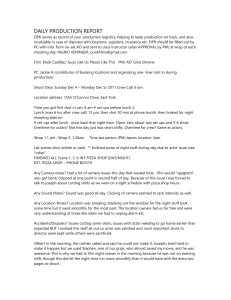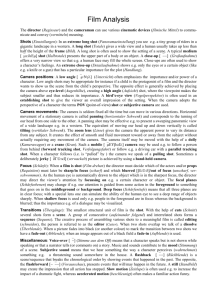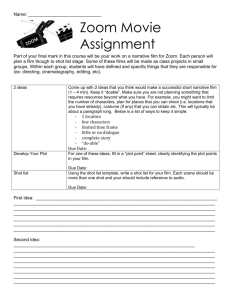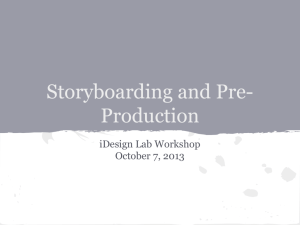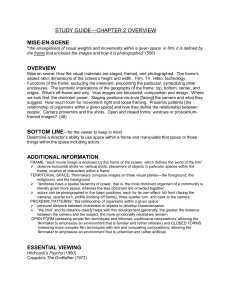Acting for Camera - Parkway C-2
advertisement
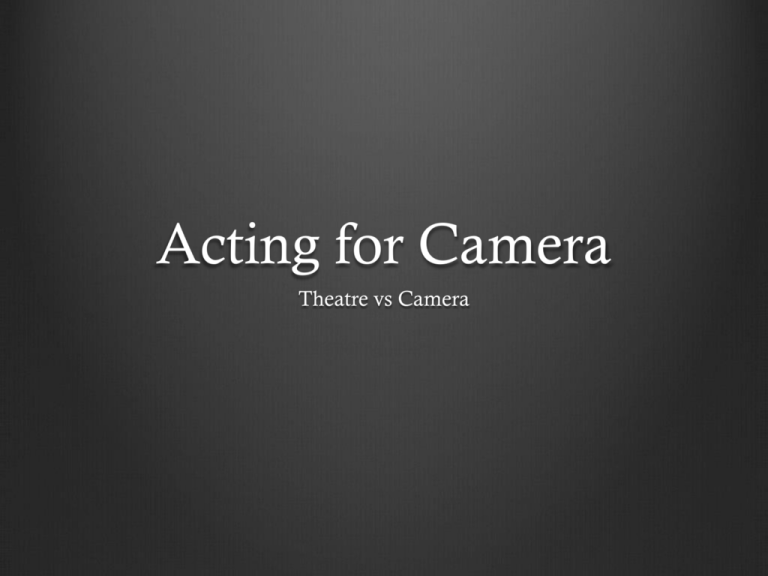
Acting for Camera Theatre vs Camera How are they the same? How are the different? In both an actor’s primary function is to communicate ideas and emotions to the audience. Both require discipline and a deep understanding of who your character is and how they fit into the story. In the theatre the audience is anywhere from a few feet to several hundred feet away. Energy must be taken into account, as well as facial expressions, gestures, the voice, sight lines, etc.. In film/TV the audience is generally only a few feet away from the screen. This means they are approx. the same distance as normal communication. As a result the smallest details will “read” to all audience members. In theatre the size of the performer will not change – the laws of physics must apply (although lighting can manipulate this). In film/tv the size of the performer is not a natural size – the camera is right on top of the performer. In theatre the audience decides where they want to look. In film the camera (and through extension the director and editor) makes the decisions. While technical theatre has made leaps and strides, all special effects must happen within the time of the show. Actors can react in real time. In film/tv special effects can be laid in later – meaning performers may be “performing” with talent that doesn’t really exist. So is one easier than the other? No – each have their own benefits and challenges. Theatre – you must memorize lines, you must stay in the moment/character through out the performance, you must memorize blocking, performance order is however the playwright wrote it – although usually it’s sequential, greaterthan-life style, all of your work/performance is seen. Film/TV – memorization is by scene instead of by character, performance might be out of order, characterization is “on demand” as several hours or days might be between your last shot and this one, subtle choices read better, some (if not all) of your work may be edited out and never seen. What is the biggest stage actor to film actor mistake? Making you choices too big – the camera will show everything – let the audience “fill in the blanks”. That is their job. They want to participate – let them . Feeling the audience will not understand what your character is feeling . The audience is on your side. They paid the money to see you and want to empathize (or at least understand) your character. Remember that almost all emotions are universal. Example. When Greta Garbo was starring in the film Queen Christina, she was unsure of what to do at the end of the movie as no dialogue or stage business was written into the screenplay. The movie is about a young queen who is worshiped by her subjects. She falls in love with the Spanish emissary and abdicates her throne so she can be with him. She goes to his ship to meet him, only to find him dying as a result of a duel with the villain and he dies. The director (Rouben Mamoulian) came up with the idea of filming her saying nothing – only moving slowly to the front of the ship, looking out, not blinking. In previews the audience’s comments ranged from “so vulnerable!” to “so courageous!” In keeping it simple the audience filled in the blanks. A quote by Laurence Olivier “At that time, stage-acting and film-acting were thought of as two entirely different crafts, even professions. We know now that this is not by any means a true assessment; the truth is infinitely subtler. They call for the same ingredients, but in different proportions. The precise differences may take some years of puzzling work to appreciate; in each case there are many subtle variations according to the character of the actor. It took me many years to learn to film-act; at least tow of these were appallingly rough and ready from sheer prejudice and ignorance. After that, it was necessary to relearn how to act on stage ,incorporating though, the truth demanded by the cinema and thereby reducing the measure of theatricality. Quote by Michael Caine “If you catch somebody “acting” in a movie, that actor is doing it wrong. The moment he’s caught “performing” for the camera, the actor has blow his cover. He’d no longer a private character in a private world. Now he’s a highly paid actor on contract to speak these lines for the public. Goodbye illusion. Good-bye career.” “In the early talkies, actors came to the movies from a theatre tradition, and, not surprisingly ,they performed in a way that was designed for the theatre.” Film/TV Vocab A A/B: Literally, “as before;” often refers to when a camera shot is to be the same as the previous one. ACTION: The order the director or first assistant gives to begin the scene. ACTION LINE: A header appearing in a script before each scene or shot detailing the characters, their location within the scene, entrances, etc. that will occur during the following action. ACTION PROPS: Objects used or handled by actors, as opposed to props used only as set dressing. AFM: Assistant Floor Manager. ASPECT RATIO: The width to height ratio of a screen: 4 to 3 or 1.33:1 (normal TV screen); 1.85:1 (standard American wide screen); 2.35:1 (wide screen such as Panavision). ASSISTANT DIRECTOR: The film director’s main link, help (and bully boy). ATMOSPHERE (Also known as ATMOS): The background sound recorded to cover possible unevennessin previously recorded background sounds from different shots. Film/TV Vocab B BACK LIGHT: Lights the back of the actor’s head/body as seen by the camera (to make the actor stand out from the background). Can be used to create a “halo” effect. BACKGROUND ACTION: The action of the extras (or supporting) artists at the rear of the shot in order to add a backdrop to the main action; e.g., the bustle of a crowd. BANANA: Walking on a curved line, usually to allow the camera to see you earlier or to prevent masking a fellow actor or to increase the time used by the movement. BEAT: A small pause; also a unit of action determined by a single character intention. BEST BOY: Chief assistant to the GAFFER (the chief electrician). BG: Background. BLOCKING THE SCENE: Giving the moves for a scene (can apply both to actors and cameras); this is usually done during the first rehearsal. BOOM: Telescopic arm, usually mounted on a moveable platform, that holds the microphone above the action but out of camera shot. It may also refer to a movable arm that attaches the camera to a DOLLY. BOOM UP/DOWN: Moving the boom and its microphone up and down; or the camera up/down. BREAK: Cease working for a while. “Take a break.” BUSINESS (or BIZ): Actions for an actor, usually involving a prop. Contrasts with movement that refers to an actor moving from one place to another. Can also refer to the business aspects of the film industry. Film/TV Vocab C CAMERA ANGLE: How high, low, and in which direction the camera is to point. CAMERA CARDS: Cards attached to a camera in a multi-camera studio telling the operator what sort of shot (e.g., close up or CU) they should do at what time (e.g., shot number 56). CHEATING: The art and craft of doing something that is untrue, but appears true to the camera; as in “Cheat your eyes or body towards camera; Cheat your height by standing on this box.” CLAPPER BOARD (also CLAPSTICK BOARD; SLATE): Used for shot, scene and take number in film (not video); it has a hinged piece that gives the satisfying clap at the start of a film sequence that helps them synchronize sound and picture in the editing. CLOSE-UP (or CU): A shot that includes only the face, or the neck and face (sometimes shoulders) of one actor. CONTINUITY GIRL (Also SCRIPT GIRL): The person who takes copious continuity notes (and Polaroid photos) so that the same props are located in the same spots and the same business is done at the same time on all shots covering the same sequence. CONTRAST RATIO: The difference between the brightest and darkest part of the picture; the human eye can cope with a contrast ratio of 100:1; film less than that and video much less than that – leading to difficulties in shooting video against sunny windows because the faces appear too dark. CRAB: Moving the camera sideways. Sometimes done on a “Crab Dolly.” CRANE: A device that can raise the camera up; small ones take it up to six feet up; giant ones can take it up to look down on roof tops. Film/TV Vocab C (cont.) CRAWL: Very slow movement of the camera. CROSS-CUTTING: To cut back and forth, especially between two unrelated scenes where things are happening simultaneously; used in editing. CROSSING THE LINE: The crime of getting the geography wrong and confusing the audience as to 2 where everyone is. If two shots are taken of two actors talking to each other, then both cameras should be on the same side of an imaginary line drawn between them; if they are on opposite sides of the line, the two actors on screen will seem to be looking in the same direction rather than talking to each other. CU: Close up. CUE (Also Q): The signal to begin; often given as a hand signal from one of the production team. CUE CARDS: Large sheets or cards containing the performer’s lines (also called IDIOT CARDS); nowadays often replaced with the TELEPROMPTER. CUT: The point where one shot is changed for another, either by editing (“I want to CUT as you get up out of the chair to leave”) or in the multi-camera studio (“I want to CUT from the close-up on Camera 1 to the wide shot on Camera 3 as the door opens”); also used to stop everything, the opposite of ACTION. CUTTER: The person who joins the chosen bits of different takes together to make the finished product. Also called the EDITOR. CYCLORAMA: A large backdrop, sometimes painted to illustrate that a scene shot inside a studio is actually occurring out of doors; sometimes it is blue and functions as a “blue screen” backdrop on which a wide variety of settings may be projected subsequent to the shooting of the scene. Film/TV Vocab D DAILIES (also RUSHES): Shots from the day before, quickly developed in order to show to all interested people in case anything needs to be re-shot. Actors usually don’t get to see them (which is often wise). DEEP FOCUS: The system of wide lenses and small apertures that allow objects close (foreground)and far away (background) from the camera to be in focus. DEEPER: Farther away. DEPTH-OF-FIELD: The area that is in focus. DISSOLVE: Cross-fading from one picture to another, usually indicating passage of time. DOLLY: The truck on wheels that allows the camera to move about the studio or to follow the action. DOLLYING (Also TRACKING; TRUCKING): The act of the camera moving to follow the action. DRY RUN: Running through a scene without all the special effects that will be there in an actual TAKE. DUBBING: Transferring all the sound effects, music, replaced voices, etc. onto the finished product (tape). Film/TV Vocab E ECU: Extreme Closeup. EDITOR: The person who joins the chosen bits of different takes together to make the finished product. Also called the CUTTER. ELS: Extreme long shot. Taken from far away. ESTABLISHING SHOT: The shot at the beginning of a scene that lets the audience know where they are. EYELINE: The direction an actor takes when looking at the other actor. Directors often like the camera to “get into the EYELINE” – it means that both the eyes of the actor will be seen, and so they can do more with them. Film/TV Vocab F FG: Foreground. The area nearest to the camera. FILL LIGHT: The light that fills in the shadows caused by the KEY LIGHT. FINE CUT: The final assembly of the filmed material. This is usually what the audience will see. FISHPOLE: A hand held portable boom with a microphone allowing the mike to get close to the performer and yet stay out of frame (camera range). FULL SHOT: A shot of the full body of an actor framed at the feet, or beyond. FREEZE FRAME: Where the action in “frozen” by keeping one picture (frame) going; sometimes used to end a scene. Film/TV Vocab G-K GAFFER: Chief electrician. GRIP: Person who transports and sets up the camera equipment; “stage hands.” HAND-HELD: When the camera is hoisted onto the cameraperson’s shoulder (or otherwise held manually)so the cameraperson can follow the action without a moveable CAMERA BOOM. IDIOT CARDS: Large sheets/cards containing the performer’s lines (also called CUE CARDS); nowadays often replaced with the TELEPROMPTER. IN THE CAN: The finished product. A satisfactory recording or TAKE, as in “we have got it IN THE CAN.” KEY LIGHT: The main light for an actor usually coming in over the top of the camera often slightly off to one side, e.g. from the right or left of the camera. KILL: Stop or turn off, as in “KILL that light.” Professional Unions Screen Actors Guild - Performers are eligible to join Screen Actors Guild after working on a SAG film in a principal role, gaining "Taft Hartley" status 15 days after the first day of work - or meeting background entry requirements. Cost = To become a SAG member, the current national initiation fee rate is $2277.00 PLUS the first semiannual dues. Dues are based on a sliding scale, with the amount determined by how much you earn under SAG contracts. Each SAG member pays annual base dues of $116.00. In addition members pay 1.85% of all individual earnings under SAG contracts between $1 and $200,000; and 0.5% of earnings from $200,001 through $500,000; plus 0.25% of earnings from $500,001 to a maximum of $1,000,000. Professional Unions (cont) American Federation of Television and Radio Artists (AFTRA) is a national labor union representing over 70,000 performers, journalists and other artists working in the entertainment and news media. AFTRA's scope of representation covers broadcast, public and cable television (news, sports and weather; drama and comedy, soaps, talk and variety shows, documentaries, children's programming, reality and game shows); radio (news, commercials, hosted programs); sound recordings (CDs, singles, Broadway cast albums, audio books); "non-broadcast" and industrial material as well as Internet and digital programming. AFTRA members perform in television and radio advertising, nonbroadcast video, audio books and messaging, and provide their skills for developing technologies such as interactive games and Internet material. Cost= New members must complete an application and pay a one-time initiation fee and dues for the current dues period. The initiation fee is $1,600 and minimum dues are $63.90. After joining, a member's dues are based on his or her AFTRA earnings during the previous year. Members who earned less than $2,000 annually pay only the minimum amount of $63.90. Members are billed twice a year. Exercise for next class Learn the script given to you in class today. Next class we have 3 projects to do – working with Advanced Broadcast class on their project. Record the scene you are working on with each other 2 times, once in a far shot and once with a series of close ups. Film Vocab L-M LINED SCRIPT:A copy of the shooting script which is prepared by the script supervisor during production to indicate, via notations and vertical lines drawn directly onto the script pages, exactly what coverage has been shot. A given vertical line may indicate, via the line's start and end point, what script material is covered in a particular shot and whether given dialog or action is on-screen or off-screen in the shot, indicated by the line changing between straight and wavy respectively. Different colored lines may also represent certain types of shots: close-up, insert, long shot, etc. The lined script also frequently incorporates the script supervisor's script notes on the facing pages for a given scene. The lined script is used by the film editor as a reference to what coverage was shot and to changes made to the script during production. Lined scripts give editors a quick view of all available coverage at a glance, so that he or she can make quick editing decisions without having to sort through all the footage repeatedly. LS: Long shot. Shot from a distance. MARKS: Tape or chalk marks to indicate where a performer should stand or where they should come to after a move: “Be sure to hit your MARK.” MASTER SHOT: A wide shot that includes one or more actors. It tracks with the movement of the performers in the scene. A master shot may be uninterrupted from the beginning of a scene, or it may be interrupted several times because the director knows he/she will break it up in its final edited form anyway. This is a usually wide angle shot of the entire scene that is done first so that everyone knows what lighting and positional movements have to be matched for all subsequent shots. MATCHING: Editing several pieces (usually CLOSE-UPS and OVER-THE-SHOULDER SHOTS) with a MASTER SHOT in order to produce a final “scene” in which the important material receives proper coverage and emphasis in a carefully integrated manner. Film Vocab M-O MATCHING: Editing several pieces (usually CLOSE-UPS and OVER-THESHOULDER SHOTS) with a MASTER SHOT in order to produce a final “scene” in which the important material receives proper coverage and emphasis in a carefully integrated manner. MCU: Medium close-up shot. MIXER: Technician who mixes together the various inputs from the different microphones to get the proper sound. MOS: Made without sound. Also MUTE. MS: Medium shot. OC: Off-camera; out of view of the camera and therefore not seen. OVER-THE-SHOULDER SHOT: A shot in which we look across the back of one actor to the face of the other. Often simply OTS. Film Vocab P PAN: Rotating the camera head horizontally while keeping the base still. POV: A POINT OF VIEW shot shows what a character sees. “Subjective camera.” POST-PRODUCTION: Everything that happens to a production after the shooting has finished, such as editing, dubbing, special effects, etc. PRACTICAL: A working prop; may be used to describe anything that actually works, such as a lamp, stove, sink, radio, etc. PRODUCTION ASSISTANT: In film, the assistant to the producer; in television, the person responsible for logging all shots, timing them, and noting down all TIME CODES, and taking continuity notes. Film Vocab R RACKING FOCUS: With a shallow depth of field, changing the focus from foreground to background, or vice versa. REACTION SHOT: The shot of what one actor is doing or “thinking” while the other is speaking. REVERSES: Shooting the opposite direction of what you have just done. “After shooting all the shots of the person speaking to you, we will now do all your REVERSES.” ROLL TAPE: The act of beginning to tape a video recording. ROUGH CUT: The first rough editing of a sequence. RUNNING: What the camera operator says when the camera is ready and stabilized to start shooting. RUNNING ORDER: The actual order in which the scenes will be recorded. RUNNING TIME: The length of a program. RUSHES: See DAILIES. Film Vocab S SCRIPT GIRL: See CONTINUITY GIRL. SETUP: Every camera position or change in photographic composition is called a “setup.” SHOOTING SCRIPT: The final approved script, often with cameras and cutting points marked in. SHOTS: The pictures taken by the camera. See TAKE. SINGLE: Shot of one person, usually in a medium closeup. Also ONE-SHOT. SLATE: See CLAPPER BOARD. SLUG LINE: A header appearing in a script before each scene or shot detailing the location, date, and time that relates to the following action. Film Vocab S SOFT: Slightly out of focus. Fuzzy. SPECIAL EFFECTS: Anything that is achieved by tricks such as miniatures, computer generated images, split screen. S continued on next page) SPIKING THE CAMERA: When the actor, usually accidentally looks directly into the lens of the camera, thereby destroying the illusion. STORYBOARD: The cartoon-like layout visualizing all the shots planned and how they relate to each other. STRIKE: To remove or take away. Film Vocab T TAKE: A take refers to a scene that is actually being filmed, as opposed to a rehearsal. TELEPROMPTER: Trade name for the device in the studio that has the script rolling across the camera lens so the actor/performer can read the lines. Often replaces CUE CARDS and IDIOT CARDS. Also called AUTOCUE. THREE-SHOT: Three people in frame; 3-S. TIGHT: Close. TILT: Vertical movement of the camera head. Camera tilts up to look up and tilts down to look down. TWO-SHOT: A shot that includes two people in the scene in the frame. Also DOUBLE or 2-S. Film Vocab V and W VOICE-OVER (VO): The disembodied voice that speaks while pictures are shown. Popular with commercials. VTR: Video tape recorder/recording. WAIST SHOT: A shot of an actor framed from the waist up. WEB: The practice of using objects (furniture, trees, stationary props, etc.) with triangulation to locate your MARK without obviously looking at the MARK. WIDE ANGLE: The camera “sees” a broad view. WIPES: Transitional techniques including: Flip Wipe: Ending scene appears to turn over on its vertical, horizontal, or diagonal axis, being replaced by the new scene as if it were on the reverse side of a card or sheet of paper. Natural Wipe: Using a prop or actor in the scene to complete obliterate the scene before the transition takes place. WRAP: The end. WS: Wide shot.

